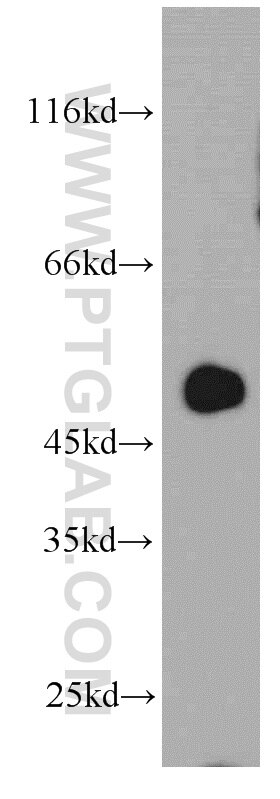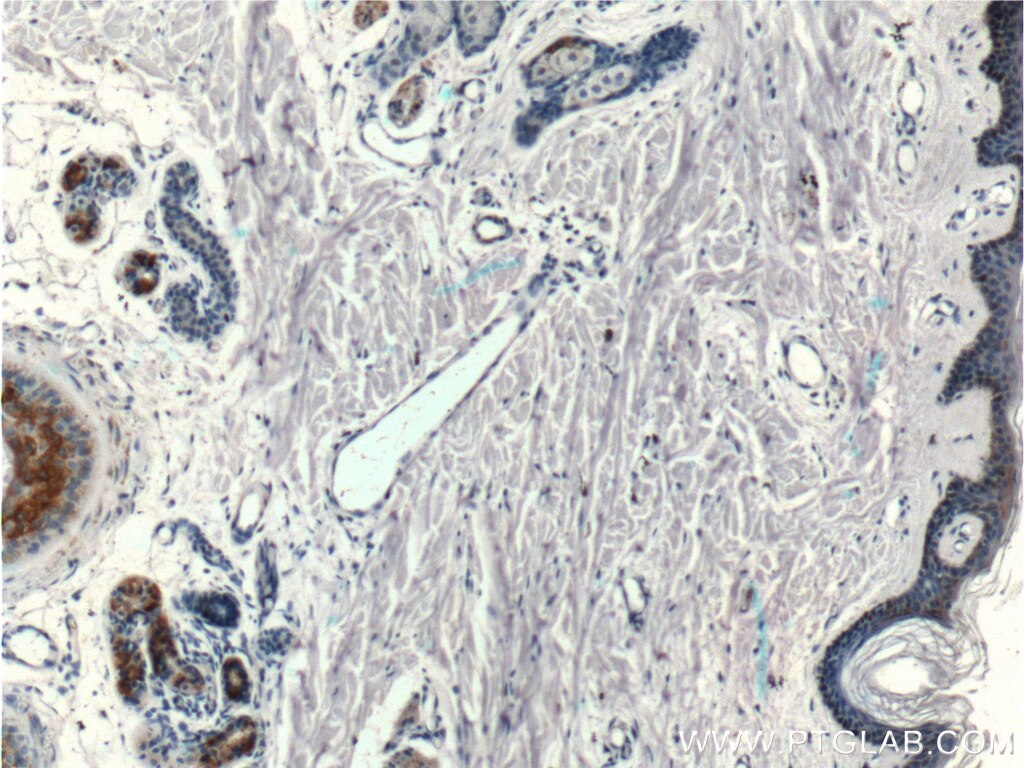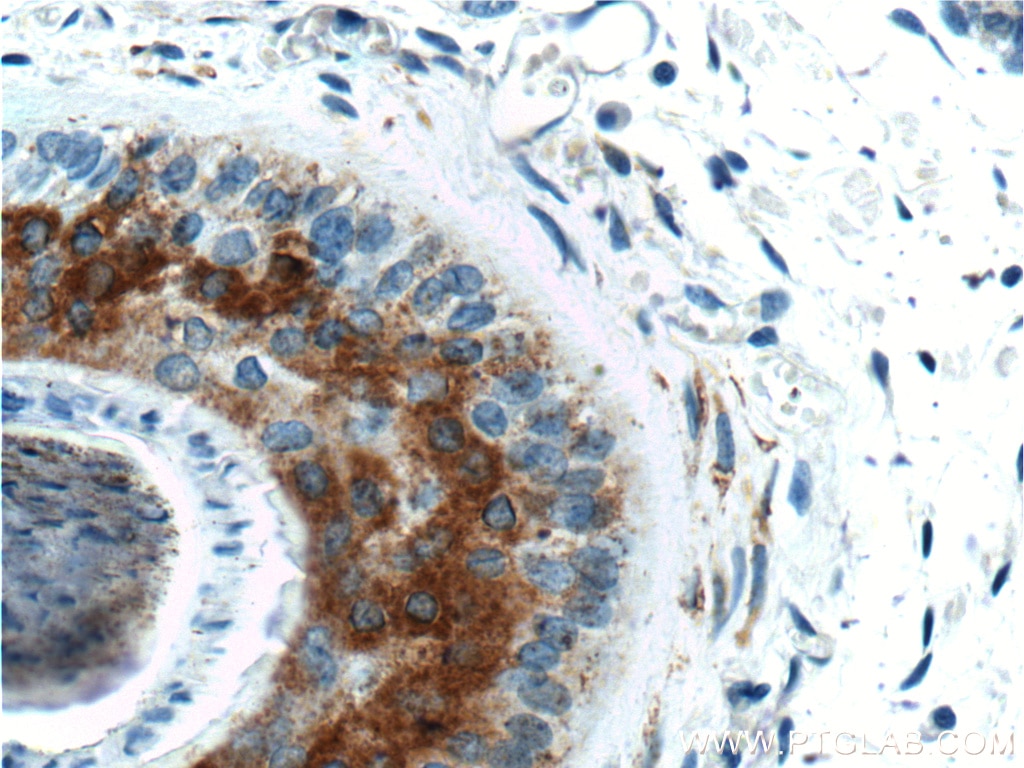- Phare
- Validé par KD/KO
Anticorps Polyclonal de lapin anti-ST3GAL5
ST3GAL5 Polyclonal Antibody for WB, IHC, ELISA
Hôte / Isotype
Lapin / IgG
Réactivité testée
Humain, souris
Applications
WB, IF, IHC, ELISA
Conjugaison
Non conjugué
N° de cat : 14614-1-AP
Synonymes
Galerie de données de validation
Applications testées
| Résultats positifs en WB | cellules HEK-293, cellules HeLa, cellules Jurkat, tissu placentaire humain, tissu testiculaire humain |
| Résultats positifs en IHC | tissu de muscle squelettique de souris, tissu cutané humain, tissu de muscle squelettique humain il est suggéré de démasquer l'antigène avec un tampon de TE buffer pH 9.0; (*) À défaut, 'le démasquage de l'antigène peut être 'effectué avec un tampon citrate pH 6,0. |
Dilution recommandée
| Application | Dilution |
|---|---|
| Western Blot (WB) | WB : 1:500-1:1000 |
| Immunohistochimie (IHC) | IHC : 1:50-1:500 |
| It is recommended that this reagent should be titrated in each testing system to obtain optimal results. | |
| Sample-dependent, check data in validation data gallery | |
Applications publiées
| KD/KO | See 1 publications below |
| WB | See 3 publications below |
| IHC | See 2 publications below |
| IF | See 1 publications below |
Informations sur le produit
14614-1-AP cible ST3GAL5 dans les applications de WB, IF, IHC, ELISA et montre une réactivité avec des échantillons Humain, souris
| Réactivité | Humain, souris |
| Réactivité citée | Humain, souris |
| Hôte / Isotype | Lapin / IgG |
| Clonalité | Polyclonal |
| Type | Anticorps |
| Immunogène | ST3GAL5 Protéine recombinante Ag6207 |
| Nom complet | ST3 beta-galactoside alpha-2,3-sialyltransferase 5 |
| Masse moléculaire calculée | 48 kDa |
| Poids moléculaire observé | 45-50 kDa |
| Numéro d’acquisition GenBank | BC065936 |
| Symbole du gène | ST3GAL5 |
| Identification du gène (NCBI) | 8869 |
| Conjugaison | Non conjugué |
| Forme | Liquide |
| Méthode de purification | Purification par affinité contre l'antigène |
| Tampon de stockage | PBS avec azoture de sodium à 0,02 % et glycérol à 50 % pH 7,3 |
| Conditions de stockage | Stocker à -20°C. Stable pendant un an après l'expédition. L'aliquotage n'est pas nécessaire pour le stockage à -20oC Les 20ul contiennent 0,1% de BSA. |
Informations générales
ST3GAL5 is also named as SIAT9, GM3 synthase, ST3Gal V, Sialyltransferase 9 and belongs to the glycosyltransferase 29 family. ST3GAL5 transfers the sialyl group (N-acetyl-alpha-neuraminyl or NeuAc) from CMP-NeuAc to the non-reducing terminal galactose of glycosphingolipids forming gangliosides (PMID:9822625, PMID:16934889). SIAT9 is mainly involved in the biosynthesis of ganglioside GM3 but can also use different glycolipids as substrate acceptors such as D-galactosylceramide (GalCer), asialo-GM2 (GA2) and asialo-GM1 (GA1) (PMID:16934889). ST3GAL5 is highly expressed in brain, skeletal muscle, placenta, and testis. And mRNA of ST3GAL5 is widely distributed in human brain, but slightly elevated expression was observed in the cerebral cortex, temporal lobe, and putamen (PMID:9822625). ST3GAL5 has 3 isoforms with the molecular mass of 45, 46, and 48 kDa. Sometimes the band of 70 kDa can also be observed, which may be a glycosylated form of ST3GAL5 (PMID: 34943806, PMID: 26458842).
Protocole
| Product Specific Protocols | |
|---|---|
| WB protocol for ST3GAL5 antibody 14614-1-AP | Download protocol |
| IHC protocol for ST3GAL5 antibody 14614-1-AP | Download protocol |
| Standard Protocols | |
|---|---|
| Click here to view our Standard Protocols |
Publications
| Species | Application | Title |
|---|---|---|
Front Immunol Identification of ST3GAL5 as a prognostic biomarker correlating with CD8+ T cell exhaustion in clear cell renal cell carcinoma | ||
Front Cell Dev Biol PRC2-dependent regulation of ganglioside expression during dedifferentiation contributes to the proliferation and migration of vascular smooth muscle cells | ||
iScience C-Myc-induced hypersialylation of small cell lung cancer facilitates pro-tumoral phenotypes of macrophages | ||
Mol Oncol Exosomes secreted by ST3GAL5high cancer cells promote peritoneal dissemination by establishing a pre-metastatic microenvironment
|












